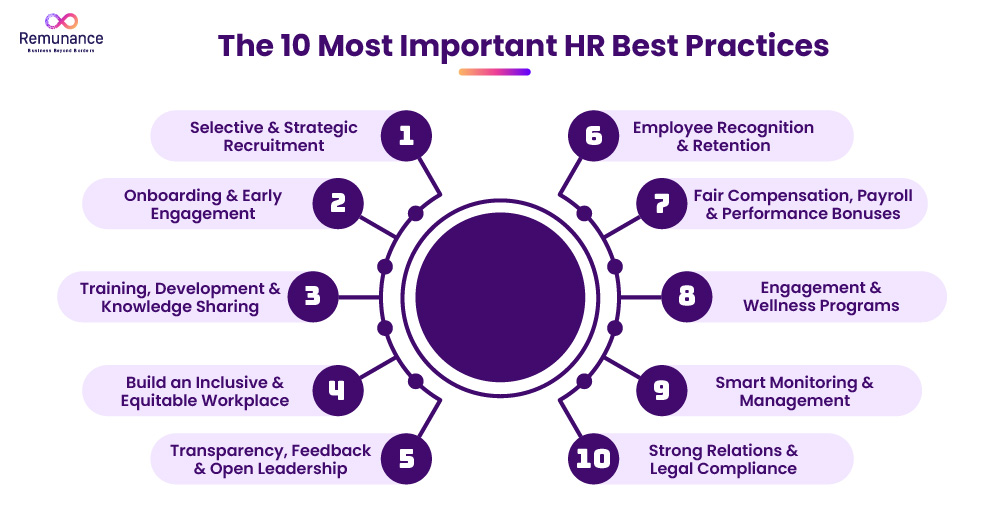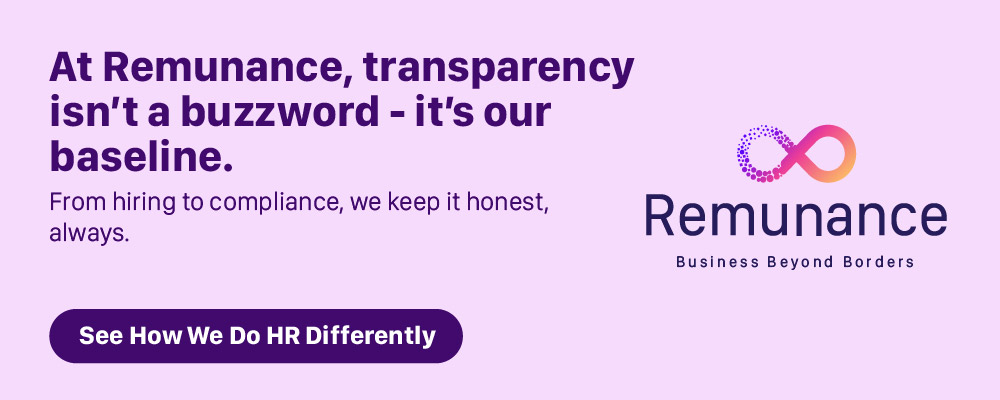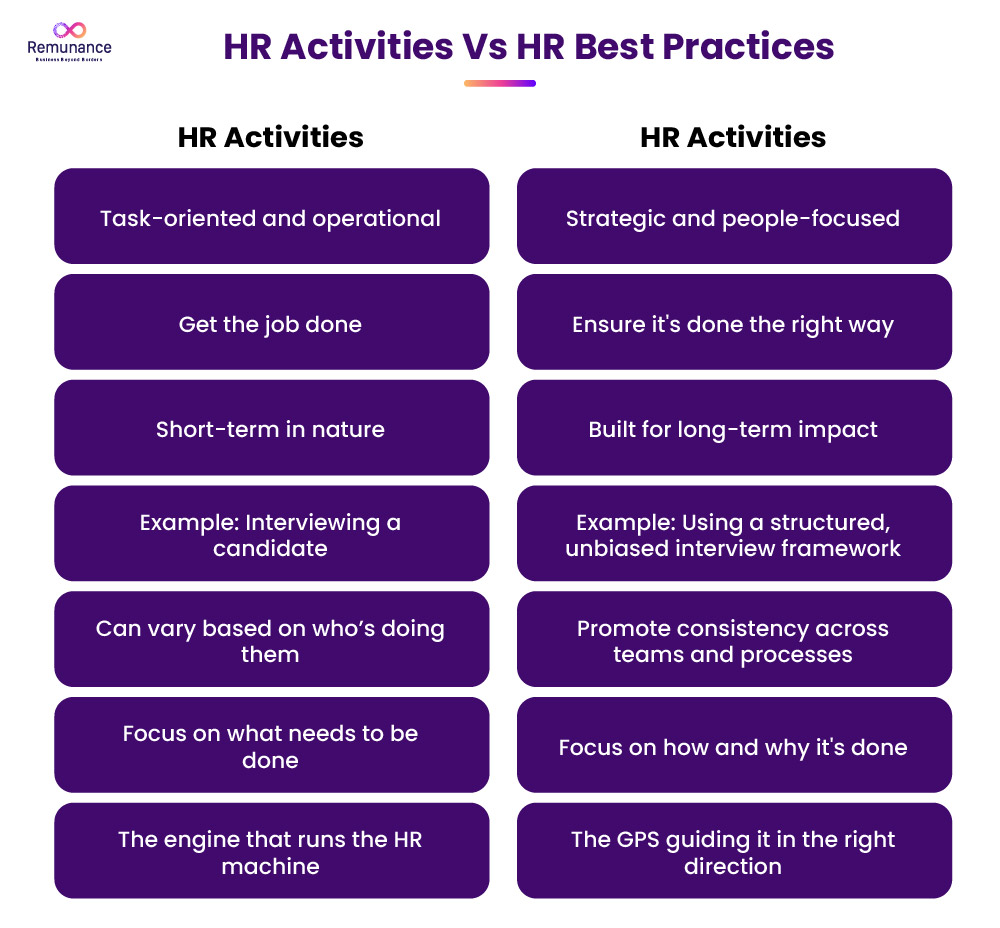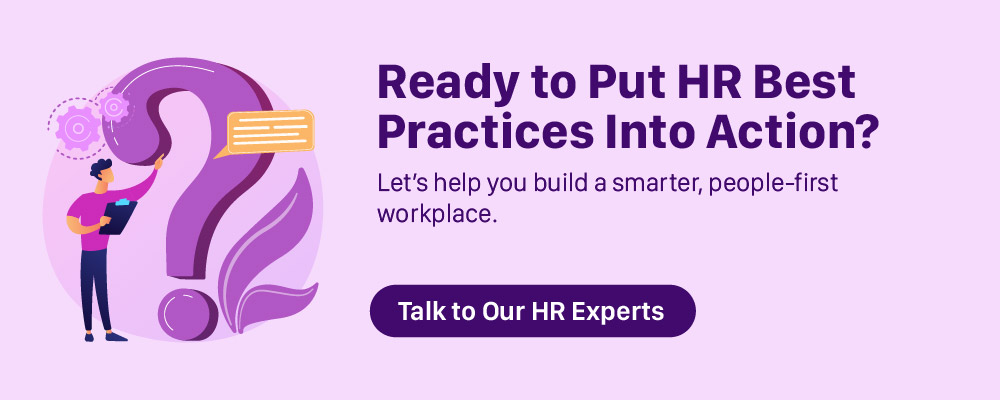Summary:
In 2025, HR is more than a basic task. It’s a growth driver. This blog breaks down the 10 best HR practices. Practices that help scale teams, boost employee engagement, and align business goals. Smart HR strategies fuel long-term success. They help you implement just the right actions to retain top talent.
In 2025, companies are shifting from routine HR tasks to best HR practices. This change focuses on long-term business growth rather than just managing admin work.
The rise of best HR practices is no coincidence. It’s being driven by:
-
- Changing employee expectations
- Rapid tech advancements in HR tools
- The need to attract and retain top talent
- A stronger focus on company culture and performance
Businesses are starting to see that great HR isn’t just support, it’s strategy. It plays a direct role in scaling teams, improving engagement, and driving results.
In this blog, we’ll break down what HR best practices really mean. You’ll learn about 10 essential practices every business should follow. You’ll understand how they fuel business growth and see how they differ from standard HR activities.
We’ll also show you how to choose the right employment partner to put these practices into action.
Let’s get into it.
What Are the Best HR Practices?
What are the best HR practices, really? HR best practices are the smart moves that help companies build a stronger, happier workforce. We’re talking about a holistic approach here. From hiring the right people to keeping them engaged, trained, and growing with the business.
When done right, these practices do more than just check boxes. They drive real results. Higher productivity. Lower turnover. A workplace culture that doesn’t just exist but actually works.
A great HR team isn’t just about paperwork and policies. It’s about people, purpose, and progress.
Key Elements of Modern HR Practices
Today’s HR is much more advanced than you can comprehend. Here’s what good HR looks like in action:
-
- Recruitment: Hiring is more about finding the right fit than just filling roles.
- Onboarding: A smooth welcome sets the tone for long-term success.
- Training: Mandatory learning modules that actually help people upgrade their skills.
- Engagement: Keeping people motivated, involved, and heard.
- Compliance: Staying 10 steps ahead of international and local employment policies.
- Retention: Replacing a valuable resource should be your last resort. This process is expensive and can highly impact productivity.
Why HR Best Practices Actually Matter?
People-first companies perform better—full stop. Stats back it up: businesses that get HR right are 2.5x more likely to be industry leaders.
Investing in smart HR practices shouldn’t be mistaken for chasing trends. It’s about building a team that grows with your company. It improves experience, cuts costs, and helps your business scale with fewer growing pains.
In short, better HR = better business.
The 10 Most Important HR Best Practices

Here’s how to elevate your people strategy and build a high-performing, future-ready workforce.
1. Selective & Strategic Recruitment
Hiring right comes with being proactive, not reactive. One of the best HR practices today is being selective and focused in recruiting.
Companies today avoid expensive mis-hires and long hiring cycles. Effective recruitment connects high-impact hiring efforts by mapping current and future talent needs.
Selective Recruitment
Building the right team starts by identifying role requirements, not just job descriptions. Go deeper into personality, values, and long-term fit. This ensures quality hires that stick.
-
- Fit
- Focus
- Quality
Strategic Recruitment
Strategic recruitment means leveraging data, using talent pipelines, and aligning recruitment timing with growth initiatives.
-
- Planning
- Forecasting
- Sourcing
Learn how to find the right recruitment partner for hiring in India
2. Onboarding & Early Engagement
A new hire’s first few weeks are make-or-break. Human resources best practices now focus heavily on employee experience starting from Day 1.
Structured onboarding accelerates learning, boosts early confidence, and dramatically improves retention. According to Oak Engage, strong onboarding improves new hire retention by 82%.
Onboarding
Don’t stop at paperwork. Onboarding should cover cultural alignment, tech setup, and goal-setting within the first week. It should feel like a guided path, not a checklist.
-
- Orientation
- Clarity
- Connection
Employee Engagement
Early engagement builds trust. Introduce them to team rituals, give them real work early, and pair them with a mentor. Show them where they matter. Here’s what should be covered in employee engagement:
-
- Purpose
- Belonging
- Motivation
Learn how Remunance effectively manages employee onboarding
3. Training, Development & Knowledge Sharing
For any HR strategy for business growth to work, you need to build talent from the inside. This is one of the most overlooked yet high-impact human resource practices.
Training and Development
Learning doesn’t stop after onboarding. Whether it’s workshops, microlearning, or mentorship, training boosts employee capability and satisfaction. HR best practices should cover:
-
- Skills
- Coaching
- Learning
Employee Development and Training
Go beyond skills—build careers. Map development paths, host regular check-ins, and offer project-based learning to encourage real growth. Focus on:
-
- Career goals
- Feedback
- Progress
Knowledge Sharing
A culture of knowledge-sharing improves team collaboration and preserves critical skills. Document workflows, run lunch-and-learns, and use internal wikis. Focus on:
-
- Systems
- Access
- Collaboration
4. Build an Inclusive & Equitable Workplace
In the current day scenario, inclusion is more essential than optional. According to Forbes, diverse companies are 70% more likely to capture new markets. This makes a smart HR strategy for business growth.
Enhancing Workplace Diversity
Diversity goes beyond representation. It’s about removing systemic barriers in hiring, promotion, and team dynamics. Review data often and audit processes regularly. Focus on:
-
- Equity
- Representation
- Access
Inclusive Workplace
Create spaces where people feel safe to speak and contribute. Use inclusive language, run bias training, and highlight stories from all levels. Focus on:
-
- Belonging
- Respect
- Voice
5. Transparency, Feedback & Open Leadership
When leadership hides behind closed doors, people check out. The best HR practices emphasize openness, clarity, and responsiveness.
Transparency
Be upfront about changes, performance metrics, and decisions. Clear internal communication prevents confusion and builds trust. Focus on:
-
- Honesty
- Access
- Communication
Feedback
Don’t wait for annual reviews. Use 360-degree feedback, surveys, and one-on-one sessions to continuously improve teams and leadership. Focus on:
-
- Listening
- Response
- Action
An Open Leadership Style
Leaders should be visible, approachable, and accountable. That doesn’t mean oversharing—it means real connection. Prioritize:
-
- Authenticity
- Availability
- Trust
6. Employee Recognition & Retention
If you don’t recognize effort, your best people will leave. It’s needless to say that retention is cheaper than rehiring. Protecting your top talent is undeniably one of the best HR practices to follow.
Employee Recognition
Celebrate wins, big or small. Use public praise, internal newsletters, or reward systems to reinforce behaviors that support your values. Prioritize:
-
- Appreciation
- Reward
- Morale
Retention
Retention starts with listening. Run “stay interviews” to learn what keeps your team happy. Address friction before it becomes attrition. Focus on:
-
- Loyalty
- Fit
- Growth
7. Fair Compensation, Payroll & Performance Bonuses
Money matters, but fairness matters more. Fair, transparent systems keep trust high and turnover low.
Fair Compensation
Benchmark pay regularly. Close wage gaps, explain pay bands, and reward based on value, not just tenure. Prioritize:
-
- Equity
- Clarity
- Consistency
Payroll
Timely, error-free payroll is basic, but critical. A tight payroll system reduces errors and saves hours of manual work. Focus on:
-
- Accuracy
- Timing
- Compliance
Learn how EOR manages payroll services in India
Performance Linked Bonuses
Tie bonuses to individual and team results. This aligns personal goals with company outcomes. This is a core part of any HR strategy for business growth.
Focus on:
-
- Incentives
- Results
- Motivation
8. Engagement & Wellness Programs
A burned-out team hardly delivers any quality work. Human resource practices that include wellness are now central, not optional.
According to the golden words of Sir Richard Branson, founder of the Virgin Group, “Train people well enough so they can leave. Treat them well enough so they don’t have to”.
Employee Well-being Programs
Support mental, physical, and emotional health. Offer counseling, flexible hours, and wellness stipends to keep teams balanced and focused. Focus on:
-
- Health
- Flexibility
- Energy
Employee Benefits
Your benefits package is a reflection of your values. Go beyond insurance. Offer parental leave, mental health, fertility support, or remote work options. Prioritize:
-
- Coverage
- Perks
- Value
9. Smart Monitoring & Management
Good management starts with good data. One of the best HR practices is making people decisions based on real-time insight, not gut instinct.
Performance Management
Use continuous performance check-ins instead of annual reviews. Set clear goals, coach regularly, and measure progress.
Automated HR Data Management
From headcount planning to turnover tracking, automation saves time and boosts accuracy. Use dashboards and analytics to spot trends early. Upgrade:
-
- Systems
- Insight
- Efficiency
10. Strong Relations & Legal Compliance
Without solid policies and people skills, HR can’t protect the company or the team.
Employee Relations
Handle conflicts early. Train managers on empathy, and provide channels for feedback and resolution. Focus on:
-
- Mediation
- Communication
- Fairness
Ensure Compliance
Stay updated on labor laws, run regular audits, and ensure all employees are trained on policies. Compliance is protection for everyone.
Implement these best HR practices with the right intention. You’ll build an HR foundation that makes business growth unstoppable.
The Role of HR Best Practices in Business Growth
When human resource practices are applied effectively, they speed up the growth process significantly. Human resource practices build strong teams and keep employees motivated.
Aligning HR with Business Strategy
-
- Workforce planning: Best HR practices align roles and skills with the long-term talent needs.
- HR as a growth partner: HR must move beyond admin to actively shape business outcomes.
- Talent planning with intent: Align hiring and talent development according to business infrastructure, budget, etc.
Adapting to Change
-
- Quick course-correction: Use insights and feedback to pivot before issues escalate.
- Flexible frameworks: Design human resources best practices that adapt to shifts in scale or market.
Using Data for Impact
-
- Predictive analytics: Forecast hiring and retention challenges early.
- Outcome-based tracking: Tie HR metrics to actual business performance.
Data-driven human resources best practices make HR indispensable.
Purpose-Driven Engagement
-
- Honest communication: Build trust through clarity during high-growth transitions.
- Meaningful work models: Link employee roles to the mission for deeper engagement.
Building for Scalability
-
- Growth-ready culture: Embed scalable values into daily operations.
- Crisis-ready policies: Ensure that your human resource practices can handle the unexpected. Prepare for disruption, not just growth.
What Is the Difference Between HR Best Practices and HR Activities?
-
- HR activities are the basics. Things like recruiting, processing payroll, or scheduling training. Best HR practices, on the other hand, are thoughtful, tested methods. They actually improve how your team works and grows.
- Think of it this way: activities get things done. However, best HR practices make sure you’re doing the right things the right way.
-
- Activities are task-oriented, usually short-term. But human resources best practices are strategic. They’re designed to support people and performance in the long run.
-
- Interviewing someone is an activity. But having a structured, unbiased interview process? That’s the best HR practice that leads to better hires.
-
- Human resource practices include both—what you do and how you do it. The difference is whether you’re just completing a task or following a proven approach.
-
- Best HR practices create consistency across teams and processes. While regular activities might vary depending on who’s handling them.
-
- In short, activities are the engine, but human resources best practices are the GPS.
Let’s now raise the question that plausibly has the most undecisive answer. How will you choose the right employment partner for you? Move to the next section for the answer.
Choose an Employment Partner that Helps You Meet the HR Best Practices
The right employment partner should help you embed best HR practices into your business. And they should help you inculcate them in the most effortless way possible.
Here’s what you should expect from your employment partner:
-
- Policy Development
Get help creating clear, localized HR policies. This should include employee handbooks, leave rules, and fair disciplinary steps grounded in human resource practices.
- Policy Development
-
- Compliance Management
Stay ahead of labor laws, wage norms, and statutory benefits as part of human resources best practices.
- Compliance Management
-
- Fast Response Time
Your employment partner should always be on their toes if your team experiences any kind of snag. This supports a stronger and reliable HR strategy for business growth.
- Fast Response Time
-
- Talent Lifecycle Support
From onboarding to succession planning, apply best HR practices consistently at every employee stage.
- Talent Lifecycle Support
Conclusion
The right partner elevates how you think about work. When your human resource practices are well-structured and backed by human resources best practices, you reduce risk and implement real operational efficiency.
Best HR practices aren’t just nice-to-haves. That’s how resilient, high-performing teams are built.
FAQs
Why are HR best practices so important for business growth in 2025?
To be honest, a business cannot grow in 2025 without a good people strategy. With hybrid work models in place, the entry of Gen Z into the professional world, and automation taking away mundane activities, the HR is no more just hiring. It’s about preparing a future-ready culture that stimulates innovation, productivity, and long-term retention.
What are some fundamental changes in HR strategies for business managers to consider in 2025?
Personalisation is the answer. Employees expect work to work for them. With times like these, HR must now move from a one-size-fits-all approach in policies to customised employee experiences such as flexible work, mental health support, skills-based hiring, and applying data in people decisions that impact business outcomes quickly and directly.
How can small businesses implement HR best practices on smaller budgets?
Here is the great thing: You really do not need enterprise-sized budgets to be people-smart. Put your focus on the few things that really make a difference: from clear communication to simple HR tech tools to a culture that really values employee opinions and turns feedback into positive change. That alone will make your company stand out in the talent market, plus consider even offering flexible hours or opportunities for learning.
Which HR tech tools will be must-haves for growth companies in 2025?
Plus, you absolutely cannot have merely every shiny HR tool available. One or two however can truly upgrade your world–an AI-enabled applicant tracking system perhaps, performance management software, and the easiest of all to use onboarding tool. Even better if your tools layer over each other and grant analytics on the fly.
How do you make HR strategies align with larger business goals meaningfully?
It begins at perceiving HR as a growth engine; not in support. Sit on the strategy table. Understand the business goals and then map talent plans to match those goals. Whether it is upskilling of teams or even retention, or hiring for future roles—HR guides the ship rather than filling the potholes.







 Consult an Expert
Consult an Expert